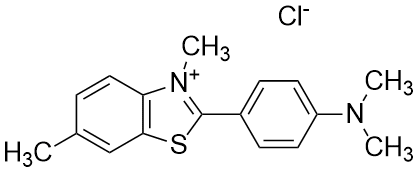Thioflavin T is widely utilized in research focused on:
- Protein Aggregation Studies: It is commonly used as a fluorescent dye to detect amyloid fibrils in various neurodegenerative diseases, helping researchers understand conditions like Alzheimer's.
- Cellular Imaging: This compound is employed in live-cell imaging to visualize cellular structures and processes, providing insights into cell behavior and function.
- Drug Discovery: Thioflavin T is valuable in screening potential drug candidates that target protein misfolding, aiding pharmaceutical companies in developing effective treatments.
- Environmental Monitoring: It can be used to assess the presence of certain pollutants in water samples, contributing to environmental safety and compliance.
- Biomarker Development: The compound plays a role in the identification of biomarkers for various diseases, enhancing diagnostic capabilities in clinical settings.
General Information
Properties
Safety and Regulations
Applications
Thioflavin T is widely utilized in research focused on:
- Protein Aggregation Studies: It is commonly used as a fluorescent dye to detect amyloid fibrils in various neurodegenerative diseases, helping researchers understand conditions like Alzheimer's.
- Cellular Imaging: This compound is employed in live-cell imaging to visualize cellular structures and processes, providing insights into cell behavior and function.
- Drug Discovery: Thioflavin T is valuable in screening potential drug candidates that target protein misfolding, aiding pharmaceutical companies in developing effective treatments.
- Environmental Monitoring: It can be used to assess the presence of certain pollutants in water samples, contributing to environmental safety and compliance.
- Biomarker Development: The compound plays a role in the identification of biomarkers for various diseases, enhancing diagnostic capabilities in clinical settings.
Documents
Safety Data Sheets (SDS)
The SDS provides comprehensive safety information on handling, storage, and disposal of the product.
Product Specification (PS)
The PS provides a comprehensive breakdown of the product’s properties, including chemical composition, physical state, purity, and storage requirements. It also details acceptable quality ranges and the product's intended applications.
Certificates of Analysis (COA)
Search for Certificates of Analysis (COA) by entering the products Lot Number. Lot and Batch Numbers can be found on a product’s label following the words ‘Lot’ or ‘Batch’.
*Catalog Number
*Lot Number
Certificates Of Origin (COO)
This COO confirms the country where the product was manufactured, and also details the materials and components used in it and whether it is derived from natural, synthetic, or other specific sources. This certificate may be required for customs, trade, and regulatory compliance.
*Catalog Number
*Lot Number
Safety Data Sheets (SDS)
The SDS provides comprehensive safety information on handling, storage, and disposal of the product.
DownloadProduct Specification (PS)
The PS provides a comprehensive breakdown of the product’s properties, including chemical composition, physical state, purity, and storage requirements. It also details acceptable quality ranges and the product's intended applications.
DownloadCertificates of Analysis (COA)
Search for Certificates of Analysis (COA) by entering the products Lot Number. Lot and Batch Numbers can be found on a product’s label following the words ‘Lot’ or ‘Batch’.
*Catalog Number
*Lot Number
Certificates Of Origin (COO)
This COO confirms the country where the product was manufactured, and also details the materials and components used in it and whether it is derived from natural, synthetic, or other specific sources. This certificate may be required for customs, trade, and regulatory compliance.

